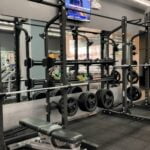Spring into action with fitness spring bar exercises. Spring bars are versatile pieces of equipment that can add a dynamic element to your workout routine. These flexible and sturdy bars provide resistance that engages various muscle groups, making them ideal for full-body workouts. Whether you’re a beginner or looking to challenge yourself with advanced exercises, incorporating a spring bar into your fitness regimen can help you achieve your workout goals.
Using a spring bar for fitness workouts offers numerous benefits. Not only does it help improve muscle strength and endurance, but it also enhances flexibility and coordination. The unique spring resistance provided by the bar allows for controlled movements that target specific muscles, promoting overall muscle development. From toning your arms and legs to sculpting your core, spring bar exercises offer a comprehensive workout experience that can be tailored to suit your fitness level.
In this article, we will explore the top 5 spring bar exercises for a full-body workout, along with tips on how to properly use the equipment for maximum effectiveness. Whether you’re just starting out or looking to take your workouts to the next level, incorporating spring bar exercises into your routine can help you achieve optimal results. So grab your spring bar and get ready to elevate your fitness game.
Benefits of Using a Spring Bar for Fitness Workouts
Using a spring bar for fitness workouts can offer a wide range of benefits for individuals looking to enhance their strength, flexibility, and overall fitness levels. This versatile piece of equipment is not only effective but also convenient to use in various settings, making it suitable for both beginners and advanced fitness enthusiasts. Here are some key benefits of incorporating a spring bar into your workout routine:
- Improved Muscle Strength: One of the primary benefits of using a spring bar for fitness workouts is the improvement in muscle strength. The resistance provided by the spring bar helps to challenge different muscle groups, leading to increased strength and endurance over time.
- Enhanced Flexibility: Spring bar exercises can help improve flexibility by stretching and lengthening muscles during each movement. This can lead to better range of motion in joints and reduced risk of injury during physical activities.
- Full Body Workout: Utilizing a spring bar allows individuals to engage multiple muscle groups simultaneously, providing a full body workout experience. This can help in achieving balanced muscle development and overall toning throughout the body.
In addition to these benefits, using a spring bar for fitness workouts can also contribute to improved posture, coordination, and cardiovascular health. Whether you are aiming to build muscle mass or simply stay active and fit, incorporating spring bar exercises into your routine can be an effective way to achieve your fitness goals. With proper technique and consistency, you can maximize the benefits of using a spring bar for your workout regimen.
- Chest Press
- Lateral Raises
- Bicep Curls
Top 5 Spring Bar Exercises for Full Body Workout
Spring bars are versatile pieces of equipment that can add an extra challenge to your fitness routine. They offer resistance that engages your muscles in a different way compared to traditional workout tools like dumbbells or resistance bands. Including spring bar exercises in your workout regimen can help you target various muscle groups and achieve a full-body workout. Here are the top 5 spring bar exercises that you can incorporate into your fitness routine for maximum effectiveness:
1. Squat Press: Start by holding the spring bar at shoulder height with your palms facing forward. Lower yourself into a squat position while keeping your chest up and back straight. As you stand back up, press the bar overhead, fully extending your arms. This exercise targets your legs, glutes, shoulders, and core.
2. Bent-Over Rows: Stand on the middle of the spring bar with feet hip-width apart. Hinge at the hips and bend your knees slightly while keeping your back flat. Grasp the bar with an overhand grip and pull it towards your abdomen, squeezing your shoulder blades together. This exercise works your upper back, biceps, and forearms.
3. Lateral Lunges: Hold the spring bar overhead with both hands while standing upright. Take a wide step to the side with one leg, lowering into a lunge position while keeping the opposite leg straight. Push off the bent leg to return to the starting position and repeat on the other side. Lateral lunges engage your inner and outer thighs, glutes, and core.
| Exercise | Main Muscle Groups Targeted |
|---|---|
| Squat Press | Legs, Glutes, Shoulders, Core |
| Bent-Over Rows | Upper Back, Biceps, Forearms |
| Lateral Lunges | Inner & Outer Thighs, Glutes, Core |
Stay consistent with these top 5 spring bar exercises for a well-rounded full-body workout that targets all major muscle groups effectively. Remember to focus on proper form and technique to prevent injury and maximize results from each exercise. Include these movements in your regular fitness routine to see improvements in strength, endurance, and overall fitness levels over time.
How to Properly Use a Spring Bar for Maximum Effectiveness
Using a spring bar for fitness workouts can be a great way to enhance your exercise routine and challenge yourself in new ways. To ensure that you are getting the most out of your spring bar exercises, it is important to use the equipment properly.
One of the key aspects of using a spring bar effectively is maintaining proper form throughout each exercise. This will not only help prevent injuries but also ensure that you are targeting the right muscles and maximizing the benefits of each movement.
When using a spring bar for exercises, it is important to start with the right tension level for your current fitness level. Spring bars typically come with adjustable resistance levels, so make sure to choose one that provides enough challenge without sacrificing proper form. It is better to start with a lighter resistance and gradually increase as you become more comfortable with the movements. This will help prevent strain or potential injury from overexerting yourself.
In addition to focusing on form and resistance level, it is essential to move through each exercise in a controlled manner. Avoid rushing through the movements or using momentum to swing the spring bar, as this can take away from the effectiveness of the workout.
Instead, concentrate on engaging your muscles throughout the entire range of motion and feeling the resistance from the spring bar working against you. By practicing proper technique and staying mindful during your workout, you can maximize the benefits of using a spring bar for your fitness routine.
Tips for Beginners Starting Spring Bar Fitness Workouts
For beginners looking to start their fitness journey with spring bar exercises, it is important to understand the basics before diving into more advanced routines. Spring bars are versatile pieces of equipment that can help improve strength, flexibility, and overall fitness levels. By incorporating spring bar exercises into your workout routine, you can target different muscle groups while also improving your balance and coordination.
One of the key benefits of using a spring bar for fitness workouts is its ability to provide resistance in both directions of movement. This means that as you push or pull on the bar, the resistance increases, challenging your muscles throughout each exercise. This progressive resistance helps increase muscle strength and endurance over time, making it an effective tool for beginners looking to build a solid foundation for their fitness journey.
To get started with spring bar exercises, it is recommended to begin with light resistance and focus on mastering proper form before increasing the intensity. Some beginner-friendly exercises include bicep curls, shoulder presses, squats, and rows. Starting with these foundational movements will help you build strength and confidence before moving on to more advanced exercises.
Additionally, incorporating proper warm-up and cool-down routines into your workouts can help prevent injuries and ensure long-term success in your fitness journey. By starting slowly and gradually increasing the intensity of your workouts, beginners can effectively build strength and improve their overall fitness levels with spring bar exercises.
Advanced Spring Bar Exercises for Those Looking to Challenge Themselves
For fitness enthusiasts looking to take their workout routines to the next level, incorporating advanced spring bar exercises can provide a challenging yet rewarding experience. These exercises not only target multiple muscle groups but also help improve coordination, balance, and strength. By adding resistance to your movements, you can push your body to new limits and achieve greater results.
To get started with advanced spring bar exercises, consider incorporating the following routines into your workout regimen:
- Single-Leg Squat: Stand on one leg with the spring bar in both hands clenched at chest level. Slowly lower yourself into a squat position while keeping your balance. Push back up to the starting position and repeat on the other leg.
- Plank Row: Begin in a plank position with the spring bar placed underneath your hands. Perform a row by pulling one end of the bar towards your chest while stabilizing your body with the other arm. Alternate sides for an effective upper body workout.
- Twisting Lunge: Hold the spring bar overhead with arms extended. Step forward into a lunge while twisting your torso towards the front leg. Return to standing position and repeat on the opposite side for a core-strengthening exercise.
By incorporating these advanced spring bar exercises into your routine, you can challenge yourself both physically and mentally while reaping the benefits of a full-body workout. Remember to maintain proper form, breathe regularly, and listen to your body’s cues to prevent injury and maximize results. Keep pushing yourself out of your comfort zone to continue progressing and achieving your fitness goals.
Combining Spring Bar With Other Fitness Equipment for Varied Workouts
When it comes to enhancing your fitness routine, combining spring bar exercises with other fitness equipment can take your workouts to the next level. By incorporating different tools and techniques, you can target various muscle groups and add variety to your routine, preventing boredom and plateaus. This fusion of equipment allows for a more dynamic workout that challenges your body in new ways.
Benefits of Combining Spring Bar With Other Fitness Equipment
One of the main advantages of integrating a spring bar with other equipment is the ability to engage multiple muscle groups simultaneously. For example, pairing the spring bar with resistance bands can provide both tension and flexibility, leading to a more comprehensive workout. Additionally, combining different tools can help improve coordination, balance, and stability, as well as enhance overall strength and endurance.
Sample Workouts Utilizing Spring Bar in Conjunction With Other Equipment
To maximize the benefits of combining spring bar exercises with other fitness equipment, consider incorporating exercises such as lunges with dumbbells while holding onto the spring bar for added stability. You can also try incorporating yoga poses or Pilates movements using the spring bar for support and resistance. Another effective way to mix things up is by adding cardio intervals like jump rope or high knees in between sets of spring bar exercises for a challenging circuit workout.
Safety Precautions and Common Mistakes to Avoid in Spring Bar Exercises
When it comes to incorporating spring bars into your fitness routine, safety should always be a top priority. These versatile pieces of equipment can provide an effective workout, but only if used correctly. In this section, we will discuss some important safety precautions to keep in mind and common mistakes to avoid when performing spring bar exercises.
Proper Warm-Up and Cool Down
Before diving into any workout using a spring bar, it is crucial to properly warm up your muscles. This helps prevent injury and prepares your body for the upcoming physical activity. A dynamic warm-up that includes movements like arm circles, leg swings, and torso twists can help increase blood flow and flexibility. Similarly, cooling down after your workout with static stretches can aid in muscle recovery and reduce stiffness.
Use Proper Form
One of the most common mistakes people make when using a spring bar is sacrificing form for quantity. It is essential to prioritize proper form over the number of repetitions to avoid strain or injury.
Focus on engaging the correct muscles throughout each exercise and move through the full range of motion to maximize effectiveness. If you find yourself struggling with maintaining proper form, consider lowering the resistance level of the spring bar until you can perform the exercise safely and effectively.
Listen to Your Body
It’s crucial to listen to your body during spring bar workouts. Pay attention to any signs of pain or discomfort and adjust your routine accordingly. Pushing through pain can lead to serious injuries, so always err on the side of caution.
If something doesn’t feel right, don’t hesitate to modify the exercise or seek guidance from a fitness professional. Remember that progress takes time, and it’s more important to work out consistently without causing harm than pushing yourself too hard too soon.
Conclusion
In conclusion, the versatility and effectiveness of spring bar workouts make them a valuable addition to any fitness routine. These exercises offer a unique way to challenge your body and build strength while incorporating elements of balance and stability. Whether you are a beginner starting out or an advanced fitness enthusiast looking to push your limits, spring bar exercises can be tailored to suit individual needs and goals.
One of the key advantages of using a spring bar for workouts is its ability to engage multiple muscle groups simultaneously, providing a comprehensive full-body workout. The resistance offered by the spring bar helps improve muscle tone, increase endurance, and enhance overall flexibility. By incorporating a variety of exercises such as squats, lunges, curls, and rows into your routine, you can target different areas of the body and achieve balanced results.
Furthermore, by combining the spring bar with other fitness equipment such as resistance bands or stability balls, you can create diverse and challenging workout routines that keep your muscles guessing. It is important to remember to always prioritize safety when performing spring bar exercises by using proper form, starting with lighter resistance levels, and gradually increasing intensity as you build strength.
With dedication and consistency, spring bar workouts can help individuals achieve their fitness goals and improve overall health and well-being.
Frequently Asked Questions
What Does a Spring Bar Workout?
A spring bar workout is a type of exercise that typically involves using a piece of equipment called a spring bar, which consists of a steel bar with springs attached to each end. This tool is used for resistance training and can be employed to work various muscles in the body, such as arms, shoulders, chest, and back.
Can You Build Muscle With a Power Twister?
Building muscle with a power twister is indeed possible, but it may not be as effective as traditional weight training exercises. The power twister primarily targets the upper body muscles, including the chest, shoulders, and arms. It can help increase muscle endurance and strength over time when used consistently.
What Muscles Does a Twister Bar Work?
The twister bar mainly works on the upper body muscles, specifically targeting the chest, shoulders, and arms. When using a twister bar for workouts or exercises like chest presses or bicep curls, these muscle groups are engaged to provide resistance against the twisting motion. Consistent use of the twister bar can help strengthen and tone these areas effectively.

Passionate about providing useful information to anyone with an interest in the field of Personal Training, I strive to pass on to our readers quality information and to answer any questions about Personal Trainers, the work they do and how to become one.





